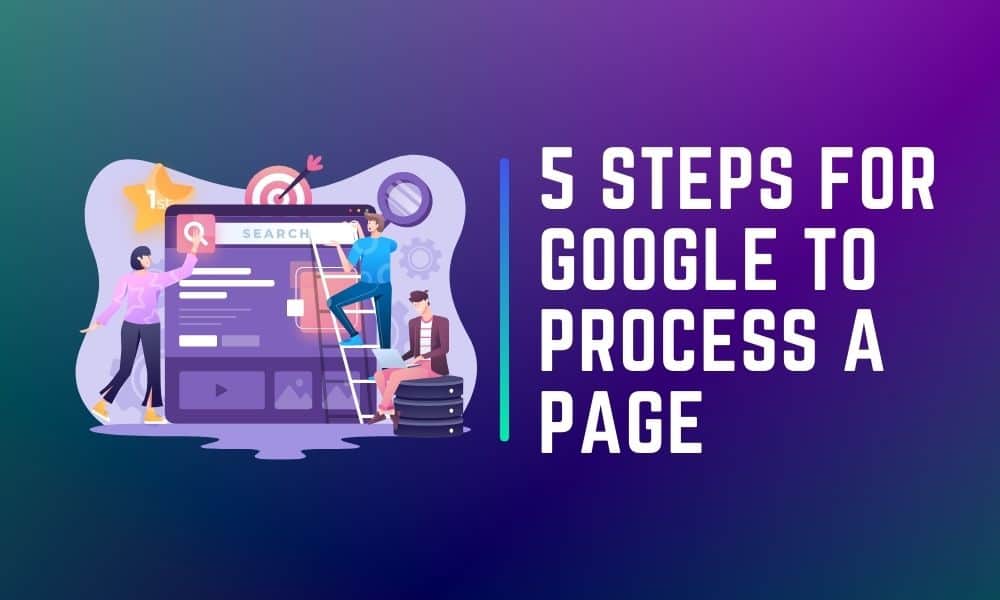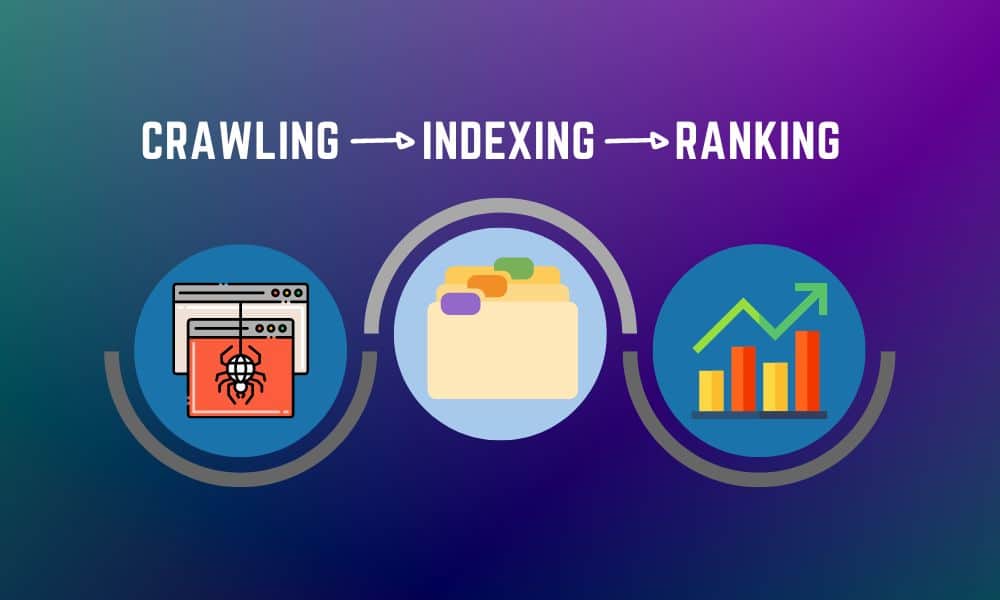Search engines like Google crawl, index, and rank (almost) all the web pages to be able to show you the most relevant answer to your search query when you need it. But how does this work and what’s the difference between crawling, indexing, and ranking?
In this article, I share the actual 5 steps that search engines take before they present the search engine results to you.
Have you ever wondered how a web page gets listed on search engines like Google? That’s what you call search indexing.

A search index is similar to a book index. Using a keyword enables the user to locate relevant information quickly. If your page is in the search index, the search engine has seen it, evaluated it, and stored it.
But before you can get into the search index and rank high on search engines, you must follow these five steps for Google to process a page.
If you want your website or new pages to be discovered, you must expose them to the search engine. And it will start with URLs. Google discovers a webpage in a variety of ways, but the four most popular are as follows:
You have two options for submitting your website to Google. Either upload an updated sitemap to your Google account or use Fetch as Google to submit an indexing request for the relevant URL.
An XML sitemap is the list of the URLs on your website. It serves as a road map for search engines to know what content is available and how to reach it. Search engines like Google read this file to help them crawl your site better. So, having a good sitemap will make it easier for search engines to crawl your site and help them discover unknown pages from your site.
An internal link is any link that connects one page of your website to another. It will also give an idea to Google the structure of your website. You should always link new content to an existing page on your website to increase its visibility. Thus, when search engines crawl your site again, they can easily discover your new web page.
Backlinks are links connecting one page of a website to another from different websites. Backlinks are also crucial for discoverability because people and search engine crawlers will follow links from other websites to your page. Importantly, they indicate to Google that the content is valuable and worth ranking high in the SERP.
Now that you have gotten search engines to discover your webpage, they can easily crawl it. Crawlers and spiders are the robots that search engines send out to find new and updated content. When they find new content, they will put it in their index called Caffeine.
Caffeine is a vast database of discovered URLs. It delivers 50% more updated online search results.
Since so many web pages could be indexed for search, this process could go on forever. However, a web crawler is more selective in its page crawling since it follows set policies. And a Robots.txt file is exactly what you need.
From an SEO point of view, the robots.txt file is very important. When bots or crawlers from a search engine visit your site, they first look for the robots.txt file. It tells search engines how to crawl your website most effectively.
But you’re not sure if you have a robots.txt file. Simply enter your root domain followed by “/robots.txt” at the end of the URL. For example, josiennation.com/robots.txt. If no “.txt” page shows up, you don’t have a live robots.txt page.
So, if you don’t have a robots.txt file on your website, you can create one. You can check the guide here. But if you use Wix, WordPress, Blogger, or another Content Management System(CMS), you might not need to change your robots.txt file directly. Instead, your provider may provide a search options page or another means to inform search engines whether to crawl your page.
Also, updating your robots.txt file on your website is important when you add pages, files, or directories that you do not want search engines or web users to index or access. It will guarantee the safety of your website and the best search engine optimization results.
A friendly reminder! You have to be careful when making changes to your robots.txt. While these changes may increase your search traffic, they may also have the opposite effect if you are not cautious.
To ensure that editing your robots.txt file will not harm your website, you can download the RankMath plugin on your WordPress dashboard. Or, read this thorough guide on editing robots.txt files.
After the search engine crawls a webpage, it will render the page. Rendering is where Googlebot retrieves your pages and runs your code and content. It will need information about HTML, JavaScript, and CSS files to give Google an idea of how your website will look from the user’s perspective.
All the information search engines get during rendering helps them rank sites based on the quality and relevance of search results.
With the recent announcement that most of the websites Google crawls are now being rendered, they added a new feature to Webmaster Tools that allows you to get a rendered preview of your website.
Rendering is an important part of indexing your site because it shows crawlers how your site gives context to any future Google searches. Google tries to figure out what’s on a page while loading or rendering. It also measures how long it takes for the page to load all the assets that visitors need to see your website.
Now, let’s see how search engines index your website.
When search engine bots understand your website’s content and structure entirely, they will index it. So, what is indexing, and how does it work?
To simplify it, Indexing is the process through which search engine crawlers store and categorize information and content found on websites.
But that doesn’t mean that a search engine has found and crawled your site; they can index it immediately. It’s essential to ensure your website is ready to be indexed because that determines whether or not it will rank in SERPs.
If your website needs to be properly optimized, important pages may not be indexed, or the parts of your website that you do not want to appear in SERPs may appear.
And it can result in less traffic to your website and a drop in ranking. Or, it can make orphan pages and duplicate content visible. An average of 16% of valuable pages of popular websites aren’t indexed. You don’t want your website to be part of the 16%.
If you want to rank on SERP, here’s how to optimize your website for indexing.
After all the “behind-the-scene” works of search engines, they can now proceed to rank a website.
Search engine rank, also called “search rank,” is the position of a webpage in the results for a specific query. Depending on the search, there may be more than one page of results.
Google uses web crawlers to scan and index pages to rank websites. Each page is rated based on Google’s evaluation of its authority and user-friendliness. According to Google, ranking higher in the search result pages for a specific query immediately indicates that you are the most relevant and reliable result.
So, if you optimized a web page, blog post, or product sheet well, it will rank higher in search engine results than those of your competitors.
There’s a lot of confusion about what exactly happens when you search for something on Google. So, I am here to help you understand the difference between crawling, indexing, and ranking in SEO.

Crawling is the first step in the process. It’s when a spider from Google crawls your website and examines its content. For your site to be crawled, you need search engines to discover your site. And you can do this by submitting URLs to Google Search Console, XML sitemap, internal links, and backlinks.
Once a search engine spider has crawled your site, it will be indexed. It means that all its pages are added to Google’s database that users can access with their searches.
Finally, search engines will rank your website. The ranking is when your content appears on search engine results pages (SERPs) based on its relevance to search terms or user queries.
I hope this post has helped you understand the difference between crawling, indexing, and ranking in SEO. Do you want to learn more about SEO? You need first to know your SEO score. Get an SEO scan for your website now!